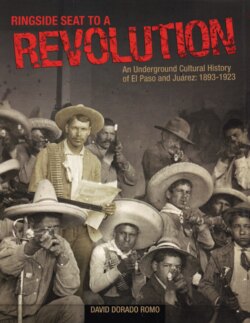Читать книгу Ringside Seat to a Revolution - David Dorado Romo - Страница 11
На сайте Литреса книга снята с продажи.
Оглавление5
Downtown El Paso, ca. 1919. (Aultman Collection, El Paso Public Library.)
made this ludic zone even hotter. Today it’s still a
place of business for pimps, drug pushers, bar own-
ers, coyotes, sex tourists, smugglers, street jugglers,
judiciales, musicians, strip dancers and those who sell
photographs of Pancho Villa.
One afternoon I was taking pictures of some
Norteño musicians walking into a bar. I snapped a
photo of their bass player; he looked like an old rev-
olucionario. Suddenly two men wearing large gold
medallions of the Virgin Mary around their neck came
up to me in a state of agitation.
“Why are you taking pictures of us?” they asked.
I told them I was aiming my camera at the musi-
cians, not them.
They insisted I show them the photos on my dig-
ital camera and erase any pictures where even their
backsides were showing.
I agreed and erased most of my photographs.
“Órale pués. We’ll let you go,” they said, “but
don’t take any more pictures, all right?”
I was beginning to realize that psychogeographi-
cal research on the border could be a dangerous
occupation, especially when you’re not sure where
you’re going or what you’re looking for.
MY MAPMAKING EXCURSIONS took me to
several zones; but almost everywhere I went, Pancho
Villa had been there before me.
I ordered an elote en vaso and a lemonade near
a Korean-owned store on Mesa and Texas Streets
where everything costs a dollar. It had once been the
Elite Confectionary. Villa and General Pascual
Orozco, who headed Madero’s troops during the
Battle of Juárez, had been there in 1911. Pancho and
Pascual didn’t like each other very much, but they
